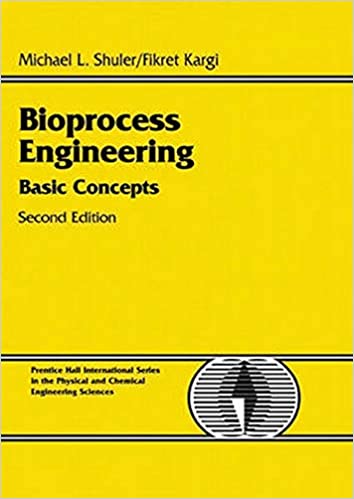
Bioprocess Engineering 2nd Edition by Fikret Kargi,Michael Shuler
Edition 2ISBN: 9780130819086
Bioprocess Engineering 2nd Edition by Fikret Kargi,Michael Shuler
Edition 2ISBN: 9780130819086 Exercise 16
Consider the case of two enzymes immobilized on the same nonporous, planar surface. S is a
substrate used by both enzymes in the following reactions:
 and
and  The final product P3 is formed by the spontaneous reaction of P1 and P2:
The final product P3 is formed by the spontaneous reaction of P1 and P2:  Reactions 1 and 2 occur only at the surface and reaction 3 is a homogeneous reaction occurring
Reactions 1 and 2 occur only at the surface and reaction 3 is a homogeneous reaction occurring
throughout the bulk liquid phase.
Figure 3.P2 gives the predicted reaction-rate dependence of reaction 1 (bottom curve) alone
and reaction 2 (top curve) alone based on the measured amount of each enzyme immobilized and
assuming the intrinsic reaction kinetics are not altered in the process of immobilization.
a.
 cm/s and the bulk concentration of substrate is 500 mg/l, what is the total rate of
cm/s and the bulk concentration of substrate is 500 mg/l, what is the total rate of
substrate disappearance?
b. What is the overall effectiveness factor under the conditions of part a?
c. What will be the ratio of P2 to P1 under the conditions of part a?
d. If you want to produce equimolar amounts of P1 and P2 and if
 what value of
what value of
bulk substrate concentration must you pick?
substrate used by both enzymes in the following reactions:

 and
and  The final product P3 is formed by the spontaneous reaction of P1 and P2:
The final product P3 is formed by the spontaneous reaction of P1 and P2:  Reactions 1 and 2 occur only at the surface and reaction 3 is a homogeneous reaction occurring
Reactions 1 and 2 occur only at the surface and reaction 3 is a homogeneous reaction occurringthroughout the bulk liquid phase.
Figure 3.P2 gives the predicted reaction-rate dependence of reaction 1 (bottom curve) alone
and reaction 2 (top curve) alone based on the measured amount of each enzyme immobilized and
assuming the intrinsic reaction kinetics are not altered in the process of immobilization.
a.
 cm/s and the bulk concentration of substrate is 500 mg/l, what is the total rate of
cm/s and the bulk concentration of substrate is 500 mg/l, what is the total rate ofsubstrate disappearance?
b. What is the overall effectiveness factor under the conditions of part a?
c. What will be the ratio of P2 to P1 under the conditions of part a?
d. If you want to produce equimolar amounts of P1 and P2 and if
 what value of
what value ofbulk substrate concentration must you pick?
Explanation
The two enzymes in the given case have b...
Bioprocess Engineering 2nd Edition by Fikret Kargi,Michael Shuler
Why don’t you like this exercise?
Other Minimum 8 character and maximum 255 character
Character 255


